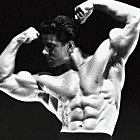 Q: You trained many elite athletes in the ’80s and ’90s. Do you still use the same training methods you used with those athletes?
Q: You trained many elite athletes in the ’80s and ’90s. Do you still use the same training methods you used with those athletes?
A: I’ve made many changes in the nutritional and supplement advice I prescribe to athletes as research or other valid information has become available. For example, I pay much more attention to maintaining optimal levels of vitamin D.
Regarding training, much of what I wrote about in the ’80s and ’90s I still do today—German Volume, German Body Comp, Cluster Training. Likewise, there are many great champion bodybuilders and strength athletes whose work influenced mine and remains relevant. Let me give you two examples.
The late British bodybuilder Reg Park won the amateur NABBA Mr. Universe in 1951 and the pro division in both ’58 and ’65. In 1973 Park made a comeback, placing second in the tall class in the pro division of that year’s Mr. Universe. At 6’1” Park had legitimate 20-inch arms, could do a strict barbell curl with 200 pounds and is credited as being the first bodybuilder to bench-press 500 pounds—which he reportedly did in street clothes! Park helped popularize the 5×5 method for developing both strength and growth. I recommend that you pick up a copy of his book Strength & Bulk Training for Weight Lifters & Body Builders.
I also recommend Anthony Ditillo’s The Development of Physical Strength, a classic that was published in 1982 and is my favorite book of all time on strength training. Like Park, Ditillo was a man who walked the talk: He packed 300 pounds of muscle on a 5’7” frame and was as strong as he looked. Among his strength feats was performing a seated press to his forehead with 435 pounds for three reps.
Ditillo believed in hard work and in striving to continually increase the amount of weight in your workouts. His workouts emphasized exercises that give the most bang for the buck, such as heavy-duty presses and rows and full-range squats—in a Ditillo workout there was no place for triceps kickbacks and plank exercises.
Editor’s note: Charles Poliquin is recognized as one of the world’s most successful strength coaches, having coached Olympic medalists in 12 different sports, including the U.S. women’s track-and-field team for the 2000 Olympics. He’s spent years researching European journals (he’s fluent in English, French and German) and speaking with other coaches and scientists in his quest to optimize training methods. For more on his books, seminars and methods, visit www.CharlesPoliquin.com. Also, see his ad on the opposite page. IM




















You must be logged in to post a comment Login